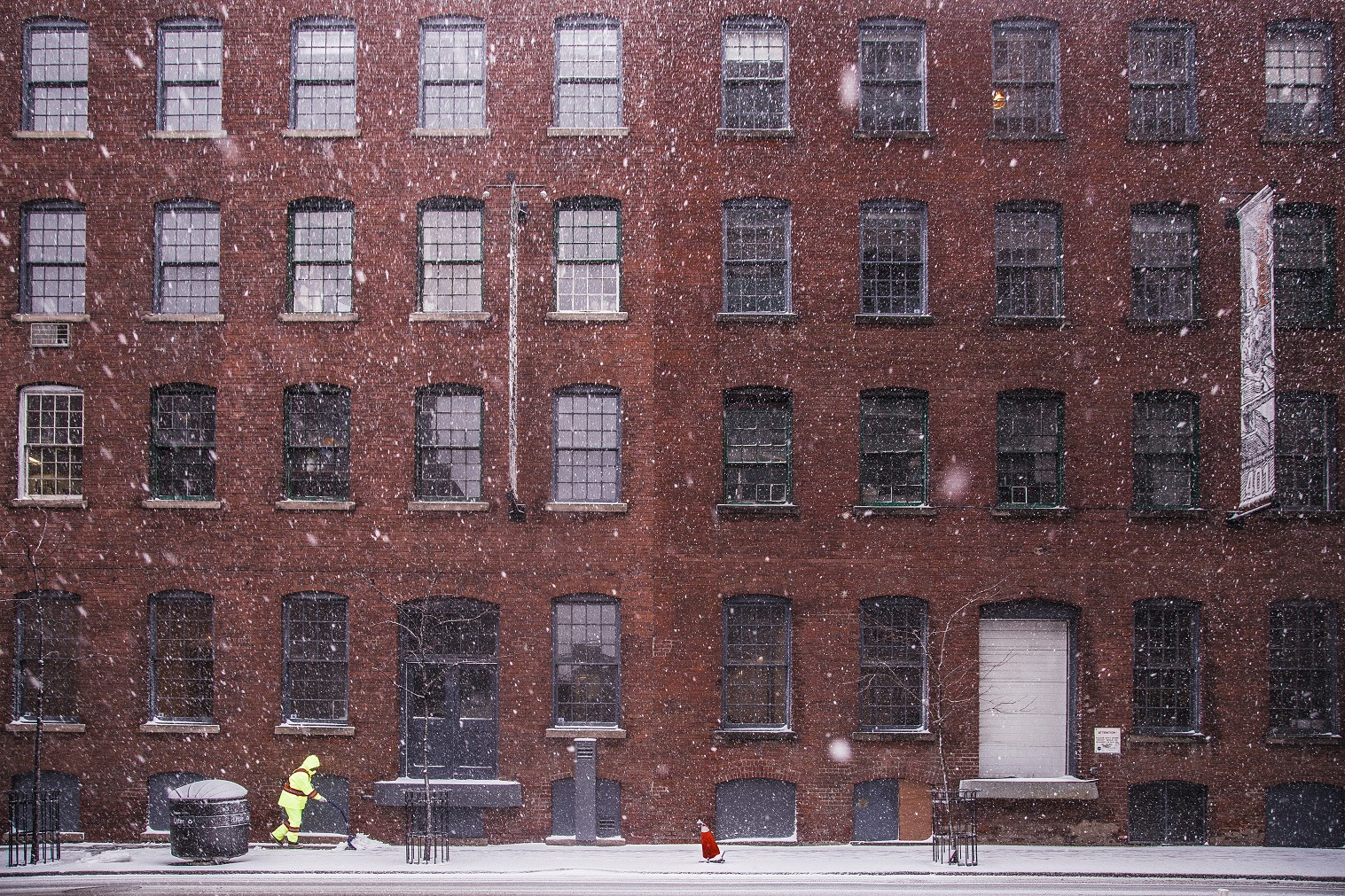Last night in Roncesvalles, a house on a very popular street had a set “offer date” and received six offers.
Who says the market is cold, right?
Sure, we could surmise that if this was January of 2022, there would have been eight offers. Or ten. Or twelve.
And we could also speculate that this house would have sold for more money in January of 2022 as well.
But it’s not the number of offers or the price that’s noteworthy in this story, but rather the content of these six offers themselves.
The six offers were all similar in one particular way, and this similarity, ironically, is the difference between this year and last.
Do you know what I’m talking about?
Some of you can hazard a guess.
All six offers were conditional.
That is how, among other reasons, the market in 2023 is different.
But now that January is in the rear-view mirror, I can’t help but look back at what was possibly the oddest month I’ve seen in real estate in quite some time.
What can we possibly say that January was?
It was slow. I think we can say that.
But slow, how, exactly?
When the TRREB stats are released on Friday or Monday, I believe that January of 2023 will show the fewest sales in any month of January in the last twenty years.
Well, let’s say almost.
For some strange reason, there were only 2,670 sales in January of 2009.
But the second-fewest sales since 2002 were the 3,968 recorded in 2019. And there’s absolutely no way we see that many sales in January of 2023.
My ‘gut’ is telling me we’re going to see around 3,000 sales. It’s just a number I’ve had in my mind since the year began, and I’ll be shocked if there’s more, but not surprised if there’s less.
But in January of 2009, despite only seeing 2,670 sales, there were a whopping 10,360 new listings. That’s a sales-to-new-listings ratio of a paltry 25.8%. I don’t think I’ve ever seen an SNLR of 25.8% in all the time I’ve been writing about real estate.
When the TRREB stats are released for this past January, I believe that the 3,000’ish sales will likely come with 6,000 to 7,000 new listings, meaning an SNLR of 40-50%.
What I mean to say is that the reason our market is slow isn’t that nobody wants to buy, but rather because there’s so little for sale.
Here’s a screenshot from an “offer night” on Wednesday:

This isn’t uncommon.
No, we’re not seeing January-2022 prices, nor are we seeing 21 of 23 offers submitted without conditions.
But we are seeing action in this market, wherever houses are being offered for sale.
Here’s a house I showed out in Milton:

That’s far from the norm out there, but it’s happening.
And here’s one that a colleague sent me in Richmond Hill:

I’m not attempting to paint a pretty picture of the market but rather provide some actual context, because so much of what’s being discussed, based on what’s being written, is inaccurate.
Case in point, this headline which I didn’t want to talk about today because “any publicity is good publicity,” and this publication goes out of its way to provide misleading and erroneous information about Toronto real estate as a strategy to attract disenfranchised Torontonians as readers, but nevertheless…

I have a very good relationship with the mainstream media. I always have. I’ve done literally hundreds of newspaper and television interviews and continue to do so when called upon.
But at the risk of ruining any working relationship that I could ever have with BlogTO, I can’t stay quiet on this one.
This headline is the worst piece of “journalism” I’ve seen in my nearly twenty years in this industry.
So look, I’ll say it. I’ll put in print what we all know: BlogTO caters to broke millennials and Gen-z’ers who hate real estate because they can’t afford what they want.
But I don’t blame BlogTO, if we’re being honest. That’s how media works. You have to pick a side. Pick an angle. Pick a slant.
A great example down south is how Fox News caters to the right and MSNBC caters to the left. It’s strategic.
Here, you could argue that the Toronto Sun caters to the right and the Toronto Star caters to the left.
I don’t like those labels, but it is what it is.
And there’s so much competition online for the eyes and minds of Torontonians that you simply can’t remain neutral in what you produce.
So BlogTO routinely puts out articles about how bad the real estate market is, and if you read the comments, you’ll see that 9/10 people are angry, hate real estate agents, hate the banks, hate investors, and are waiting for the market to drop 50% to what would be “fair.”
But this isn’t accurate.
It’s nowhere close.
And if you want to tell me I’m biased because I sell real estate for a living, I’ll accept it. But whereas I actually work in the real estate industry, not to mention went to school for commerce and economics, I can’t stand watching food critics and culture reporters write “articles” about real estate that are about as accurate as the headlines in the National Enquirer.
This is what many Torontonians are reading and this is where many many Torontonians are gaining their insights and information about the Toronto real estate market.
So let’s let the data speak.
When the TRREB stats are released, we’ll see what inventory levels look like and we’ll go from there.
In the meantime, the conclusion that I drew from January is that there’s a war going on in the market and the two participants are buyers and sellers.
But it’s not like modern warfare. It’s more like WWI, for those that consider themselves history buffs.
It’s a war of attrition.
Both sides are dug in.
Trench warfare, per World War I.
And as was the case in the early-1900’s, neither side is getting anywhere.
To illustrate, let’s use some words to describe both buyers and sellers in this market:
Sellers: stubborn, uncompromising, wishful, ignorant
Buyers: stubborn, uncompromising, wishful, ignorant
Oh, wait, they’re the exact same words. That’s awkward…
Sellers are stubborn right now. They’re refusing to accept this market for what it is. They want yesterday’s price. They want last year’s price. They are wilfully ignorant about the market, where it was, where it is, and where it’s going. Their wishful thinking about a quick rebound, a bountiful spring, or a “desperate buyer” is clouding their judgment.
Buyers are stubborn right now. They’re refusing to accept this market for what it is. They want a better price. A different price. They want the market to fall more, but they don’t want to wait for that to happen or to risk that it won’t. They’re thankless for the decline in prices that’s taken place and they’re expectant of future declines that have yet to happen in a market that’s moving sideways and where inventory is thin.
Who would have thought that the two sides could have so much in common?
Last week, a colleague of mine told me about a phone call he received from a prospective seller in Leaside. He said that she felt her house was worth “at least” $4.2 Million, and he told her that a house “like hers” hasn’t sold in Leaside for over $4,000,000 since last January.
He told her that the current market value is likely about $3,700,000 and that the $4,200,000 figure she has in mind is probably “higher than last year, and prices, as we know, have dropped.”
She immediately replied, “Not in Leaside, they haven’t.”
He gave a “huh?” as a knee-jerk response.
“Prices haven’t dropped in Leaside,” she said. “They may have dropped elsewhere, but not here.”
You see, this is the mindset of every seller out there.
Every seller has something special. “You have to see it to believe it,” a home-owner told me last December as he regaled me with details of his positively average and unspectacular home.
Sellers have invented this scenario in which, despite the GTA average home price declining 20% from the peak, representing a 20-30% decline in the suburbs and a 10-15% drop in the central core, their houses haven’t been affected.
Another colleague called me this week to shop a “pocket listing.”
She told me about the property: a 1,250 square foot, 2-bed, 3-bath, great building and location, but awful floor plan and layout.
I said, “Before you tell me what your client wants, may I guess?”
She agreed.
“This building has traded in the $1,100/sqft range,” I told her. “This unit is bigger, it’s got the 2-storey variety and huge ceilings, but it’s a bad layout and you said it hasn’t been touched in twenty years. My guess is that it’s worth about $1,300,000 but your guy is going to want $1,400,000.”
Then I paused and waited for a response.
None came.
I actually had to ask, “Hello?” to make sure she was still there.
“I’m here,” she said. And that’s when I knew she had paused for fear of providing me with a response.
“My guy is looking for about $1,600,000,” she said.
“Of course he is!” I responded.
“But why not $1,700,000?” I asked. “Why not $1,800,000?”
So many Toronto property owners are looking at real estate as a lottery right now, but one with a guaranteed prize!
It’s one thing to want last February’s price, but it’s another thing altogether to want a price that takes last February’s figure and adds ten or twenty percent.
And this is happening everywhere right now.
There are no shortage of examples of sellers and listing agents that are being irrational about the market, but there’s a property that I’ve seen listed over and over, so frequently that every time I see a “new” listing come out in this building, I merely assume it’s the same unit.
Have a look:

If you listed your condo for sale nine times in two years, would you eventually realize that the market isn’t the issue?
The amazing thing here is that the “peak” of the market was February or March of 2022 and this condo was listed for $729,000 from February 7th through May 7th, and it did not sell.
Despite knowing today that prices are down since then, the seller has re-listed at $727,900 this past week.
Oh, and that’s also after re-listing in June, September, and November at the same price.
This makes absolutely zero sense. It’s literally the definition of “futile.”
But this is how many sellers are acting right now and it doesn’t seem like it’s going to change.
I might have written about this particular house in the fall, but amazingly, it’s still relevant…
Clients of mine were eyeing a house that had been listed for $3.5 Million, was reduced to $3.4 Million, then finally reduced to $3.3Million.
They began looking last summer but knew that, if they were going to make their “last move” into a twenty-year home with their young children, they were in no rush, and wanted to see what would happen to the market.
Eventually, the house was re-listed for $2,999,9000, but with an offer date.
They went to the open house and the agent even told them, “We’re expecting well over the list price.”
The agent followed up with me and asked if we had any interest and I told him, “They’re looking at this house as though it were $2,999,000.”
He didn’t follow up again. He didn’t even bother with the ole’, “Hey man, bring me an offer on our offer night, you never know…”
That was a sign that those efforts would be pointless, and sure enough, the day after the failed offer night, the house was re-listed for $3.3 Million.
I watched this house sit on the market all through the fall until the listing finally expired at Christmas.
And when the house was re-listed in January, can you guess what they re-listed for?
$3.3 Million.
This isn’t the agent. This is the seller.
This is a seller who says, “I’m going to get what I need to get.” Or maybe it’s “want” to get. But regardless, whether the seller is independently wealthy, or financed this with no debt, or is down to his very last penny, he’s going to hold firm at his price.
His price is not market price. If it were, the house would have sold.
But determining market price is not an easy task!
Is this house worth $3.2 Million? You would think so, or less.
Is this house worth $3.1 Million?
Who am I, or who are you, to say this house is worth $3.0 Million, but isn’t worth $3.1 Million?
If a house is truly worth what somebody is willing to pay for it, then we won’t know what this house is worth until somebody buys it.
But we do know what it’s not worth, and that figure is $3.3 Million.
The buyers aren’t going to buy at that price.
The seller isn’t going to sell for less.
And therein, the war of attrition is demonstrated.
Therein, the entire month of January in the Toronto real estate market is summed up!
Buyers want more.
Sellers want more.
And the market only moves when buyers and sellers agree on price, thus one reason why we will see so few sales when the TRREB data is released. The other reason, of course, is the lack of inventory on the market.
Due to pressure from agents, TRREB has started to track re-listings as a metric, so we could start to look at sales as a percentage of net new listings as opposed to simply new listings. I do feel that, this past January, we saw a lot more houses re-listed after failed offer nights, so if we see 7,000 or 8,000 new listings, I’ll know that data is inflated!
So until Monday (or Friday if TRREB steals my thunder and releases the data…), we’ll just have to keep guessing on the hard data, and telling stories from the trenches about the soft data.
Stories about what’s actually transpiring in the market, based on agents interacting with buyers and sellers, making offers, going on listing appointments, and working in the field. As opposed to also-ran stories that pale in comparison to the sensationalized headlines we continue to see in suspect online “news” publications.
But don’t expect that to change.
Have a great weekend, everybody!
































Eddie
at 7:11 am
“But at the risk of ruining any working relationship that I could ever have with BlogTO, I can’t stay quiet on this one.”
Small loss. Half of the BlogTO article are clickbait and/or brain candy. e.g. restaurant gone out of business, restaurant hit with public health infractions, someone won the jackpot in a lottery, Environment Canada adverse weather warning for Toronto, 10 best in Toronto, someone was attacked/abused on the TTC, yada, yada.
Tony
at 12:50 pm
Who gives a flying fuuuuuuuck about BlogTO geez
JF007
at 7:49 am
they did steal the thunder..3100 sales..
https://trreb.ca/files/market-stats/market-watch/mw2301.pdf
Jenn
at 10:48 am
Wow great prediction David!
f00kie
at 8:39 am
Is the new ‘new listing’ metric taking out relistings captured anywhere for the public to see?
Appraiser
at 9:36 am
Latest U.S. employment data released this morning:
“Total nonfarm payroll employment rose by 517,000 in January, and the unemployment rate changed little at 3.4 percent, the U.S. Bureau of Labor Statistics reported today.” https://www.bls.gov/news.release/empsit.nr0.htm
Strangest recession ever.
Ace Goodheart
at 10:00 am
I am starting to think that everyone, even the Central Banks, has made the wrong call and no one sees what is actually happening right now.
You can put the situation into the usual metrics folder and get a nice snap shot of historically similar situations: A Federal government that has strayed too far left and has lost support of the majority of Canadians (and will lose the next Federal election to what looks to be shaping up as a Conservative landslide election victory – if you don’t believe me, look what is happening in Quebec – Trudeau just lost that Province, and as everyone knows, you can’t win a Federal election, even with a minority government, if you don’t win Quebec).
We also have the usual situation with over indebted households, and over indebted Federal government (Trudeau will have added pretty close to $1 trillion CDN to our Federal debt by the time he leaves office in mid 2025), and that situation almost always leads, in a complicated but predictable way, to a downturn in housing prices (look at the 1990s).
But, and this is the big but…..the main reasons why things are going downhill right now, is not because the economy is in recession. It is not. It is because of COVID, the “work from home” movement, and the “woke” movement.
The economy is not in excess demand, as the BoC seems to think. The problem is, no one wants to work. Work from home is fun. No one wants to go back. So you have to pay way more for everything, so that people can be convinced to actually go back to their jobs.
Then you have the “woke” movement and its associated “let’s tax everything to the stratosphere and try to push the world back into the Bronze age by forcing people to stop consuming”. This results in high prices, and people who want more pay for less work, because their tax burdens are too high (why work, when all you pay is tax?). If you want to actually keep your income, you need to make more of it. So prices are forced up.
Get rid of “work from home” and the “woke” movement, and you get rid of inflation. Then you have an economy that is chugging along normally and requires neither stimulus nor high interest rates.
You may see, over the next year, some weird things happening to the economy. Likely, as Canada tires of the Liberals three cardinal tenets “Climate, Indigenous and LGBTQ+” and starts asking for their government to tackle issues like health care, soaring prices and inflation, and stop the never ending tax increases on everything, you will see a return to normal work conditions. It will become “uncool” to sit in your house all day and take care of your dog, while you pretend to work at a full time job, in an office you have not seen in three years.
We are also going to see a “cleansing” to some extent of the real estate market, with people who got in over their heads exiting in distress. This will, if nothing else, make housing slightly more affordable.
I just overall do not think that any one has this situation right. Get rid of WFH and the “woke” movement and all of its taxes, and our economy is functioning normally. No recession, no inflation, nothing out of the ordinary.
Toronto Expat
at 11:16 am
As you choose to live in the distant past so shall your discomfort grow.
Ace Goodheart
at 12:12 pm
Very true.
I don’t think people are able to put 2+2 together and come up with four, yet.
Folks want the woke movement (because we have been told, over and over again, to want it, almost like some kind of mental conditioning experiment) and folks want work from home and flexibility to work when you feel like it (and when your dog doesn’t need walking or your kid doesn’t want to play, or in between vacuuming and dusting).
But folks also want the fast food style, instant service economy we used to have, with cheap prices, low taxes and a lot of personal financial freedom, all of which are completely against the woke movement’s founding principles.
It will be interesting to see which wins out in public opinion. The transition to a more state managed, supply restricted economy, with all of its high prices, shortages of basic services and goods, and strict government control of personal freedoms, that the woke movement requires, or will people decide to break free and go back to pure capitalism (with all of its associated problems)?
House Keys
at 11:27 am
While I won’t comment on the ideological points you brought up, I thought this explainer from former BoC governor Stephen Poloz was spot on:
“It is worth reflecting on why it has been so hard for economists and central banks to forecast inflation in the last while. Usually a rise in inflation comes from excess demand in the economy, and rising interest rates can act to moderate the excess demand and get inflation back to target. During the pandemic, though, the surge in inflation came mostly from supply disturbances – shutdowns, supply chain disruptions, and commodity shortfalls due to Putin’s invasion of Ukraine. What this means is that both supply and demand adjustments will play a role in the disinflation process, too, and it will be just as hard to forecast inflation on the way down as it was on the way up. Notice that a recovery in supply – due to supply chain improvements, adjustments in global commodity markets to a new geopolitical reality, and increased labour force related to immigration and higher participation of parents – will boost economic growth and push inflation down, both at the same time. This is why we need not experience a recession or a rise in unemployment in order to see inflation fall, and why the usual indicators of inflation pressures – low unemployment, rising wages, and continued economic growth – could mislead forecasters in the months ahead. Demand side adjustments are clearly underway, too, but those supply-side improvements should cause inflation to fall faster than traditional economic models would predict.”
f00kie
at 11:30 am
If you get rid of WFH (if that is indeed the issue… no comment there), how does one do that? The genie is out of the bottle.
It’s like saying we should get rid of (stock market) bubbles.
JL
at 1:34 pm
Interesting take; wanting flexibility and relaxed work conditions (leading to less productivity?) but also wanting the same service standards and product availability as before, at the same low prices. Something may indeed have to give.
Alexander
at 5:42 pm
Until 1/3 of the population does not feel really miserable and another 1/3 it barely manages all this tightening is good for nothing. Looking south of the border numbers I feel Fed has 2 options at the moment – to continue 50 point increases until US economy is sharply slowing or continue with 25 point increases here and there and having incredibly high rates somewhere in not too distant future. Those social umbrellas from the governments are simply going to prolong the misery, make countries finances break and end up with the social unrest on a huge scale.
cyber
at 10:20 pm
Wow, “nobody wants to work anymore”… 1894 coal mine owners called and want their ‘insight’ back 🙂
https://www.marketwatch.com/story/nobody-wants-to-work-anymore-has-been-said-for-100-years-it-wasnt-true-then-and-it-isnt-true-now-11659019444
PM
at 6:21 am
actually ACE most of your arguments are based on stereotypes and not facts. The main driver of the worker shortage is actually baby boomers in the 60-65 bucket who decided to retire a few years early during covid. Thats a fact, you can look it up and see labor force participation rate by age cohort. but if you want to keep blaming wokeness keep it up.
Ace Goodheart
at 3:52 pm
Yes, I am going to keep blaming wokeness.
If a bunch of 60-65 year olds want to retire, and that causes a massive labour shortage, the next question is, what are all the young folks doing?
I guess not working?
There are just so many jobs right now. It is like we are back in 1960. You can literally just walk in and you have a full time position.
But the young folks would rather be social media influencers or trade crypto, or work on their online gaming skills.
It causes inflation.
Bryan
at 9:56 am
Bollocks.
What are all the young folks doing? In the context of this argument the answer is “not existing” rather than “not working”.
In 2020 (maybe some has changed buy that’s the year for the random website I clicked), the age cohort with the highest population was age 55-59 with 2.7M people. Those are the people who retired (at some rate idk), along with the 2.5M 60-65 year olds. That is a combined 5.2M people in nd around retirement age. The people that need to replace those folks in the workforce are the 20-25 year olds and the 15-20 year olds…. but there are only 4.6 million of them. That is a 600,000 person shortfall. Do we expect young people to work multiple jobs to fill in the gap, lest they be called lazy?
Ace Goodheart
at 7:20 pm
A friend of mine just got a job working in tunnels for Metrolinx.
In his early 30s.
No skills at all. They hired him on the spot. They asked him to bring his friends and they’ll hire them.too.
Pay?
Forty seven dollars an hour. For a 44 hour work week! (For those of you who are good at math, that’s $107,000 per year.
To follow around tunnel machines and clean up. Under ground.
And he even gets overtime.
Anyone who wants to work right now, can. There is no excuse
Alex
at 2:12 pm
David, I’m with you on BlogTo. I cringe everytime I see an article from them. This one was written by Jack Landau who’s credentials are photographer and all things urban….
Ace Goodheart
at 4:58 pm
Reading an article this morning about folks who bought new build houses on contracts in Feb 2022 and now cannot close.
Many of these people appear to be investors (ie. They bought more than one house, and already have a house that they live in).
They are complaining bitterly about the unfairness of it all.
They bought a highly leveraged investment in an over heated market, and got burned.
Must be someone else’s fault.
These folks helped cause the housing crisis (by purchasing houses that they did not intend to live in, to hold as investments).
Now they want a bail out.
You can’t make this stuff up.
Different David
at 11:13 am
I read that article too. The lawyer who bought 2×2.5M homes was the best – I’m almost 100% sure that he wanted to live in the house long enough to get the personal residence exemption and then flip the houses for a cool $1M profit.
No sympathy at all for him.
David Fleming
at 12:31 pm
@ Ace & Different David
Can you kindly provide a link? Thx!
JL
at 8:05 pm
If you didn’t know the context you could easily mistake this for parody:
https://www.thestar.com/news/gta/2023/02/05/they-paid-top-dollar-for-pre-construction-homes-at-the-market-peak-now-their-builder-is-selling-the-same-models-for-far-less.html
David Fleming
at 9:01 pm
Wow.
The word “should” was used by one buyer three times.
Another provided her definition of “fair.”
The word “help” was used a whopping seven times.
But this part: “Soroha said he doesn’t know who he blames more — the builder or the Bank of Canada.”
No blame for himself, I guess? No, that would be crazy…
Ace Goodheart
at 10:37 am
It would appear the commenters on the Star story agree with us.
A large comment thread, and not a single comment in support of the buyers.
The story originally had a picture of the lawyer standing in front of three expensive looking cars. They seem to have changed that, and he is now sitting at his desk.
This guy’s biggest enemy is the person who stares back at him, whenever he looks in the mirror…..
jerry
at 6:28 am
In other words, the reason our market is slow isn’t because no one wishes to buy, but rather because there aren’t many things available to buy. Here is a picture from a Wednesday “offer night”:
Available here https://remodelingcontractorsusa.com Remodelling Contractors Services in USA